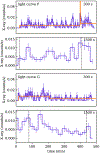Simultaneous X-Ray and Infrared Observations of Sagittarius A*'s Variability
- PMID: 32831351
- PMCID: PMC7440390
- DOI: 10.3847/1538-4357/aaf71f
Simultaneous X-Ray and Infrared Observations of Sagittarius A*'s Variability
Abstract
Emission from Saggitarius A* is highly variable at both X-ray and infrared (IR) wavelengths. Observations over the last ~20 yr have revealed X-ray flares that rise above a quiescent thermal background about once per day, while faint X-ray flares from Sgr A* are undetectable below the constant thermal emission. In contrast, the IR emission of Sgr A* is observed to be continuously variable. Recently, simultaneous observations have indicated a rise in IR flux density around the same time as every distinct X-ray flare, while the opposite is not always true (peaks in the IR emission may not be coincident with an X-ray flare). Characterizing the behavior of these simultaneous X-ray/IR events and measuring any time lag between them can constrain models of Sgr A*'s accretion flow and the flare emission mechanism. Using 100+ hours of data from a coordinated campaign between the Spitzer Space Telescope and the Chandra X-ray Observatory, we present results of the longest simultaneous IR and X-ray observations of Sgr A* taken to date. The cross-correlation between the IR and X-ray light curves in this unprecedented data set, which includes four modest X-ray/IR flares, indicates that flaring in the X-ray may lead the IR by approximately 10-20 min with 68% confidence. However, the 99.7% confidence interval on the time-lag also includes zero, i.e., the flaring remains statistically consistent with simultaneity. Long-duration and simultaneous multi-wavelength observations of additional bright flares will improve our ability to constrain the flare timing characteristics and emission mechanisms, and must be a priority for Galactic Center observing campaigns.
Keywords: Galaxy: center; accretion, accretion disks; black hole physics; radiation mechanisms: non-thermal.
Figures






References
-
- Alexander T 1997, in Astronomical Time Series, Vol 218, ed. Maoz D, Sternberg A, & Leibowitz EM (Dordrecht: Kluwer; ), 163
-
- Alexander T 2013, arXiv:13021508
-
- Baganoff FK, Bautz MW, Brandt WN, et al. 2001, Natur, 413, 45 - PubMed
-
- Baganoff FK, Maeda Y, Morris M, et al. 2003, ApJ, 591, 891
-
- Ball D, Özel F, Psaltis D, & Chan C-K 2016, ApJ, 826, 77
